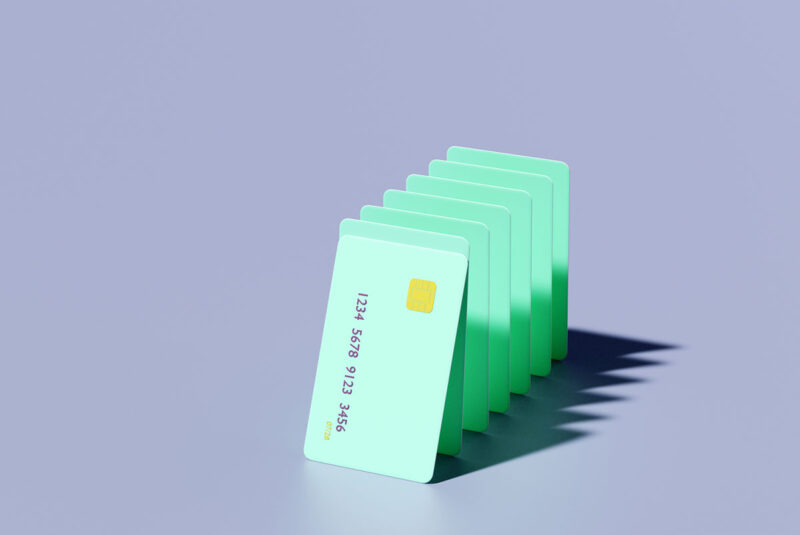Swipe, dip, or tap?
You might have to make the choice more frequently in the coming years.
That’s because contactless technology is expected to equip more than half of all new credit and debit card shipments by the end of the decade, reports The New York Times.
But how do these cards work? Are they safe? Here’s everything you need to know, plus our picks for the best contactless cards available.
Insider tip
Mastercard created a tool to let you search for merchants in your area that accept contactless payments. It also developed a similar tool, called ShopOpenings, which shows you businesses that are currently open for business along with whether or not they’re NFC-capable (which means able to take contactless payments).
What Are Contactless Credit Cards, and How Do They Work?
Contactless credit cards are plain old credit cards, for the most part, except that they allow you to pay by simply holding your card near the payment terminal, rather than swiping or inserting it. They use a contactless technology called NFC (near field communication). Each card has a contactless NFC chip and radio frequency (RFID) antenna, which is why they’re sometimes called RFID credit cards or RFID chip credit cards, too.
When you’re shopping with a contactless card, you wave it over the card reader, and your card uses radio frequencies and a one-time code to complete the transaction. There’s no need to swipe, sign, or dip. You’ll still earn the same credit card rewards you normally would for the purchase.
When you visit MoneyTips, we want you to know that you can trust what’s in front of you. We are an authoritative source of accurate and relevant financial guidance. When MoneyTips content contains a link to partner or sponsor affiliated content, we’ll clearly indicate where that happens. Any opinions, analyses, reviews or recommendations expressed in our content are of the author alone, and have not been reviewed, approved or otherwise endorsed by the advertiser.
We make every effort to provide up-to-date information; however, we do not guarantee the accuracy of the information presented. Consumers should verify terms and conditions with the institution providing the products. Some articles may contain sponsored content, content about affiliated entities or content about clients in the network. While reasonable efforts are made to maintain accurate information, the information is presented without warranty.
Although there’s been lots of buzz about contactless credit cards, the technology isn’t new.
Mastercard, for example, introduced contactless cards back in 2003, and the Chicago transit system adopted contactless payments in 2011. The London Tube has been using them since 2014. Today, quite a few Visa and American Express cards are contactless, too. You’ll also find contactless cards from Chase, Capital One, Discover, and other issuers.
Over the past decade, contactless cards have steadily grown in popularity in Canada, Europe, and Australia — and are finally gaining ground in the United States. ABI Research, a market advisory firm, predicts that, by 2022, 2.3 billion contactless cards will be issued globally each year.
The whole tap-and-go process takes a few seconds, making it infinitely faster than EMV chip cards. That’s why contactless cards are perfect for speedy transactions, like in line at a coffee shop or on a city bus.
Insider tip
Digital credit cards or digital wallets, like Apple Pay, Google Pay (formerly Android Pay), or Samsung Pay, use the same technology as contactless credit cards for mobile payments. Before using your phone or wearable at checkout, you’ll need to download or set up the appropriate tap-and-pay service for your device.
Are Contactless Credit Cards Safe?
Though the NYT says contactless cards are “significantly more secure” than magnetic-strip cards, they still have some weaknesses you should be aware of.
The biggest issue comes in the form of RFID skimmers, who use their own NFC readers to steal details from contactless cards. This can occur on busy city streets or in crowded subways when thieves can get close without drawing too much attention.
While there’s been much talk about this potential threat, some experts say it’s overblown. One told NPR most thieves would consider RFID skimming a waste of time since it’s much easier to go online and buy “thousands” of credit card numbers at once.
If you’re concerned, you can purchase an RFID-blocking wallet or wrap your card in a piece of aluminum foil.
The most important step, however, is to monitor your card’s activity like usual. The vast majority of credit cards, including tap credit cards, have a zero-liability guarantee. Just be sure to check your monthly statements and credit reports, and alert your issuer if you spot any unrecognized purchases.
Also, take heart in the fact that most issuers set limits on contactless card transactions — usually around $50 to $100. After you hit that amount, you’ll need to sign for the purchase.
Contactless Payments and Contactless Credit Cards
If you’ve ever looked into contactless credit cards, you’ve probably heard the term “contactless payments,” too. The two ideas are inherently related, but it’s worth noting that contactless credit cards are only one form of contactless payment.
Contactless Payments: Definition & History
Contactless payments are essentially any type of payment that requires no physical contact — that means no swiping of a magnetic stripe and no insertion of a chip.
This type of tech has actually been around for decades — a contactless bus payment card was implemented in Seoul in 1995, and Speedpass, which allowed customers to pay for gas with a contactless key fob loaded with money, was introduced by Mobil in the late ‘90s. Things have come a long way since then, though.
Contactless credit cards are one type of contactless payment, but contactless, tap-and-pay technology can also be embedded into devices like phones and watches. Many modern contactless technologies involve digital wallets, like Google Pay and Apple Pay.
Like the RFID antennae used by contactless credit cards, devices like smartphones use NFC technology that interacts with the payment terminal.
Which American Issuers Offer Contactless Cards?
To see if a card features contactless payment technology, look for a wave-like or field symbol on either the front or the back. That’s the contactless indicator.
You can also call your credit card issuer to see if contactless-enabled cards are available — sometimes banks will send an updated version if you ask.
As for where contactless payment methods are accepted? More and more retail locations, including McDonald’s, Starbucks, Subway, Trader Joe’s, Aldi, Walgreens, and Whole Foods. Just look for the contactless symbol on the point-of-sale terminal, or explore Mastercard’s searchable database of contactless merchants.
Insider tip
Don’t worry if a merchant doesn’t have a contactless payment system. Contactless cards are regular credit cards, just with more advanced technology. So you can use them anywhere your specific card’s accepted, including online or over the phone. And if you sign for the purchase, you won’t have the $50–$100 transaction limit you would when paying with a tap.
Are Contactless Cards the Future?
The last time contactless cards entered the American market, they didn’t make much of a splash.
But this time — with more and more merchants hopping on board, and more consumers embracing digital payment methods — we’d guess they’re going to stick around.
So get ready to tap, pay, and head off on your merry way.



